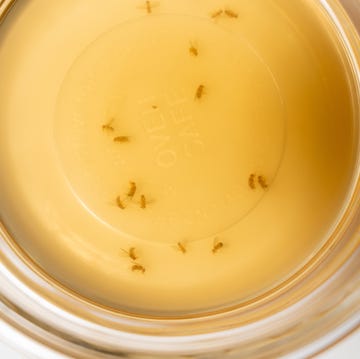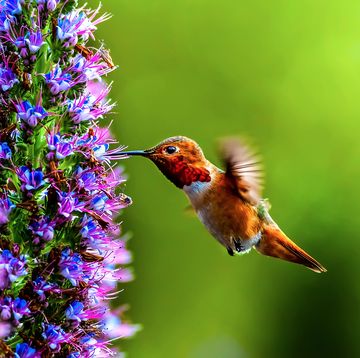1They're nicknamed "hummers."
 Getty Images
Getty Images A hummer is not only a disconcertingly large personal vehicle seen on the road, but also a colloquial way birders use to refer to their hummingbird coteries. “I saw my hummers today” would be an appropriate way to describe your regular visitors, according to LeBaron.
2Yes, you can have "your" hummers.
 Getty Images
Getty ImagesLeBaron says hummingbirds choose their favorite locations based on geography, as well as a combination of natural nectar sources and well-placed feeders.
Advertisement - Continue Reading Below
3They have amazing memories.
 KenCanning//Getty Images
KenCanning//Getty Images 4They can fly thousands of miles every year.
 Getty Images
Getty Images In terms of migratory feats, hummers go the farthest of any bird in proportion to body length, according to LeBaron. For a 2.5-inch hummingbird, the few thousand miles traveled between breeding grounds and winter habitats is positively huge. The rufous hummingbird (pictured) has the longest migration of any hummingbird species. Their annual trek covers more than 3,000 miles from Alaska and Canada to southern Mexico.
Advertisement - Continue Reading Below
5They can travel 500 miles in a single go.
 Getty Images
Getty ImagesLeBaron says some ruby-throated hummingbirds (pictured) fly 500 miles nonstop across the Gulf of Mexico during both spring and fall migrations. Others will stick to the coast and travel the longer route down the edge of Texas instead.
6Hummers are diurnal.
 David Northcott//Getty Images
David Northcott//Getty ImagesMeaning most are awake during the day and sleep at night. That being said, these special birds can migrate regardless of the time of day.
Advertisement - Continue Reading Below
7There are over 350 known hummingbird species.
 Image by David G Hemmings//Getty Images
Image by David G Hemmings//Getty Images 8They love sugar.
 Getty Images
Getty ImagesHummingbirds go straight for the glucose, says LeBaron. They can eat more than twice their body weight daily, visiting a hundred or more flowers to do so. Because of their economical proportions and an incredibly high metabolism, these excellent pollinators can't store fat like warblers and other small birds.
Advertisement - Continue Reading Below
9Don't add dye to their food.
 Getty Images
Getty ImagesNatural nectar is clear, so it's not a necessary ingredient and there's some debate over whether food coloring could harm birds. To refill you bird feeder, LeBaron says to make your own sugar water by boiling four parts water mixed with one part refined white sugar. DIYing instead of buying insures no added colors or chemicals. Other sweeteners like honey and brown sugar go rancid faster and can make hummingbirds sick.
10They are attracted to the color red.
 Kathleen Reeder Wildlife Photography//Getty Images
Kathleen Reeder Wildlife Photography//Getty ImagesHowever, it's a myth that hummingbirds will only feed on red flowers.
Advertisement - Continue Reading Below
11Hummingbird feeders need frequent cleaning.
 Getty Images
Getty ImagesYes, there is some upkeep involved. Bird feeders should be cleaned thoroughly every week with a vinegar-water solution, a task that can become quite time-consuming.
12They eat insects.
 Jeff R Clow//Getty Images
Jeff R Clow//Getty ImagesBecause of their quickness and the shape of their beaks — which act like "spring-loaded sets of chopsticks" — hummingbirds can snatch insects right out of the air.
Advertisement - Continue Reading Below
13They love certain flowers.
 Getty Images
Getty ImagesIf you want to attract hummingbirds to your yard, plant different types of blooms that flower during the entire period when hummers may appear. Landscaping with native species serves both the birds and the ecosystem. You can find out about planting in your region here.
14They visit 1,000 flowers each day.
 SusanGaryPhotography//Getty Images
SusanGaryPhotography//Getty Images Advertisement - Continue Reading Below
15They prefer natural nectar to feeders.
 Rumen Raykov / 500px//Getty Images
Rumen Raykov / 500px//Getty ImagesNatural nectar is the key to a healthy diet for these birds — so they'll always prioritize a good flower over a feeder.
16Their brains are pretty heavy compared to the rest of their bodies.
 Corey Hayes//Getty Images
Corey Hayes//Getty Images Advertisement - Continue Reading Below
17Despite their name, they don't necessarily "hum."
 Mikael Drackner//Getty Images
Mikael Drackner//Getty ImagesHummers don't produce musical sound. It's more of a chatter, experts say. Some species even make these sounds with their tail feathers.
18Hummers can really sleep.
 Getty Images
Getty ImagesHummingbirds have an evolutionary adaptation that benefits them during cold nights, according to LeBaron. Torpor is a deep sleep similar to hibernation in which the metabolic rate drops as much as 95%. This lowers the body temperature so much that a torpid hummingbird maintains a hypothermic threshold that nears death. It takes them 20 minutes to an hour to wake up from this state.
Advertisement - Continue Reading Below
19That means they can survive freezing temps.
 Getty Images
Getty ImagesPeople mistakenly worry about the cold when it comes to hummers, but it actually doesn't pose much of a risk. Some hummingbirds breed in the Andes, where temperatures drop well below freezing. Come fall or winter, the food supply is the limiting factor, not the temperature.
20Hummers beat their wings thousands of times per minute.
 Getty Images
Getty ImagesAveraging about 50 times per second, hummers redefine the laws of flight. They hover over their food instead of landing. In fact, 25 to 30% of a hummingbird’s weight is in its pectoral muscles. Their near-invisible wings can propel them forward, backward, and upside down, says LeBaron.
Advertisement - Continue Reading Below
Readers Also Read
Advertisement - Continue Reading Below
Advertisement - Continue Reading Below
































